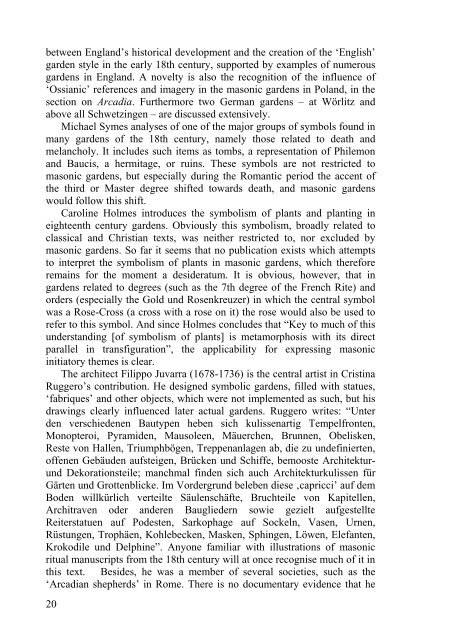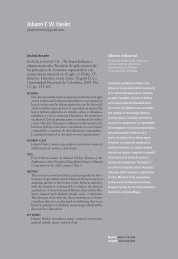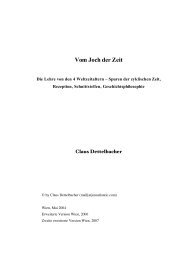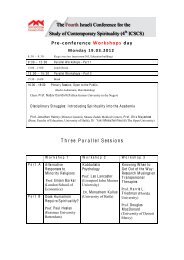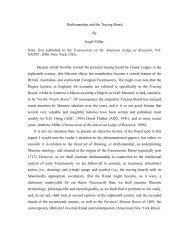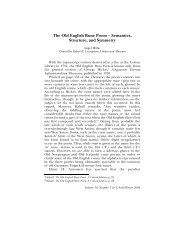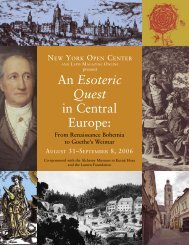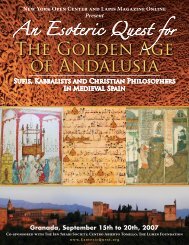Material for the introduction - Stichting OVN
Material for the introduction - Stichting OVN
Material for the introduction - Stichting OVN
Create successful ePaper yourself
Turn your PDF publications into a flip-book with our unique Google optimized e-Paper software.
etween England’s historical development and <strong>the</strong> creation of <strong>the</strong> ‘English’<br />
garden style in <strong>the</strong> early 18th century, supported by examples of numerous<br />
gardens in England. A novelty is also <strong>the</strong> recognition of <strong>the</strong> influence of<br />
‘Ossianic’ references and imagery in <strong>the</strong> masonic gardens in Poland, in <strong>the</strong><br />
section on Arcadia. Fur<strong>the</strong>rmore two German gardens – at Wörlitz and<br />
above all Schwetzingen – are discussed extensively.<br />
Michael Symes analyses of one of <strong>the</strong> major groups of symbols found in<br />
many gardens of <strong>the</strong> 18th century, namely those related to death and<br />
melancholy. It includes such items as tombs, a representation of Philemon<br />
and Baucis, a hermitage, or ruins. These symbols are not restricted to<br />
masonic gardens, but especially during <strong>the</strong> Romantic period <strong>the</strong> accent of<br />
<strong>the</strong> third or Master degree shifted towards death, and masonic gardens<br />
would follow this shift.<br />
Caroline Holmes introduces <strong>the</strong> symbolism of plants and planting in<br />
eighteenth century gardens. Obviously this symbolism, broadly related to<br />
classical and Christian texts, was nei<strong>the</strong>r restricted to, nor excluded by<br />
masonic gardens. So far it seems that no publication exists which attempts<br />
to interpret <strong>the</strong> symbolism of plants in masonic gardens, which <strong>the</strong>re<strong>for</strong>e<br />
remains <strong>for</strong> <strong>the</strong> moment a desideratum. It is obvious, however, that in<br />
gardens related to degrees (such as <strong>the</strong> 7th degree of <strong>the</strong> French Rite) and<br />
orders (especially <strong>the</strong> Gold und Rosenkreuzer) in which <strong>the</strong> central symbol<br />
was a Rose-Cross (a cross with a rose on it) <strong>the</strong> rose would also be used to<br />
refer to this symbol. And since Holmes concludes that “Key to much of this<br />
understanding [of symbolism of plants] is metamorphosis with its direct<br />
parallel in transfiguration”, <strong>the</strong> applicability <strong>for</strong> expressing masonic<br />
initiatory <strong>the</strong>mes is clear.<br />
The architect Filippo Juvarra (1678-1736) is <strong>the</strong> central artist in Cristina<br />
Ruggero’s contribution. He designed symbolic gardens, filled with statues,<br />
‘fabriques’ and o<strong>the</strong>r objects, which were not implemented as such, but his<br />
drawings clearly influenced later actual gardens. Ruggero writes: “Unter<br />
den verschiedenen Bautypen heben sich kulissenartig Tempelfronten,<br />
Monopteroi, Pyramiden, Mausoleen, Mäuerchen, Brunnen, Obelisken,<br />
Reste von Hallen, Triumphbögen, Treppenanlagen ab, die zu undefinierten,<br />
offenen Gebäuden aufsteigen, Brücken und Schiffe, bemooste Architektur-<br />
und Dekorationsteile; manchmal finden sich auch Architekturkulissen für<br />
Gärten und Grottenblicke. Im Vordergrund beleben diese ‚capricci’ auf dem<br />
Boden willkürlich verteilte Säulenschäfte, Bruchteile von Kapitellen,<br />
Architraven oder anderen Baugliedern sowie gezielt aufgestellte<br />
Reiterstatuen auf Podesten, Sarkophage auf Sockeln, Vasen, Urnen,<br />
Rüstungen, Trophäen, Kohlebecken, Masken, Sphingen, Löwen, Elefanten,<br />
Krokodile und Delphine”. Anyone familiar with illustrations of masonic<br />
ritual manuscripts from <strong>the</strong> 18th century will at once recognise much of it in<br />
this text. Besides, he was a member of several societies, such as <strong>the</strong><br />
‘Arcadian shepherds’ in Rome. There is no documentary evidence that he<br />
20


